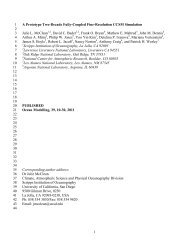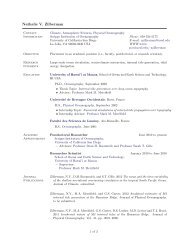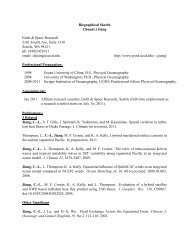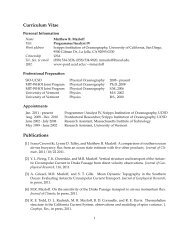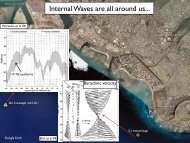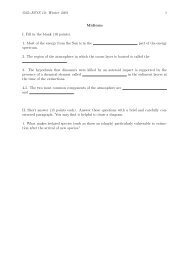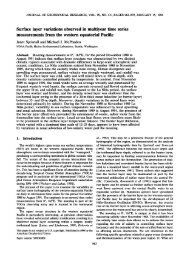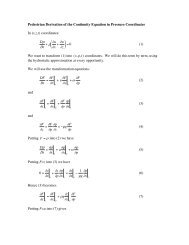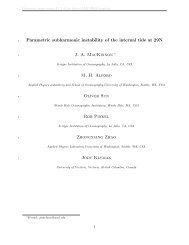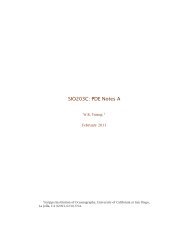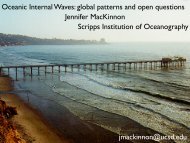Download pdf
Download pdf
Download pdf
You also want an ePaper? Increase the reach of your titles
YUMPU automatically turns print PDFs into web optimized ePapers that Google loves.
SIO 210: Global water masses and overturning<br />
Lynne Talley Fall, 2012<br />
Dec. 12 3-6 PM Final exam.<br />
Mostly CLOSED BOOK EXAM – 1 page of notes allowed, front and<br />
back, handwritten or typed. Calculators recommended.<br />
Tutorials: after class today. Next Monday and Tuesday, time TBA<br />
• Summary of circulation<br />
• Summary of water masses<br />
– Primary layers (4) for each ocean and sources<br />
– T/S<br />
• Meridional overturning<br />
• Global overturning<br />
• Role of air/sea fluxes and diffusivity<br />
• Reading: parts of DPO Chapter 14
Upper ocean circulation<br />
Gyres, western boundary currents, Antarctic Circumpolar Current,<br />
equatorial circulations Schmitz (1995) (DPO Fig. 14.1)
Absolute surface height, related to<br />
surface geostrophic velocity<br />
Maximenko et al., GRL, 2003 (DPO Fig. 14.2)
200 and 1000 dbar circulation rel. to 2000 dbar<br />
Shrinkage of<br />
strong part of<br />
ST gyres to<br />
west and pole<br />
(into the<br />
WBC)<br />
Roemmich and<br />
Gilson, 2009<br />
DPO Fig. 14.3
Surface circulation (absolute steric height from<br />
hydrography)<br />
Similar to Maximenko et al on previous slide<br />
(Reid, 1994, 1997, 2003)
Circulation at 2000 dbar (adjusted steric height) (Reid, 1994, 1997,<br />
2003)<br />
2000 dbar<br />
Greatly reduced subtropical gyres, continued ACC and equatorial<br />
zonal flows, weak circulations elsewhere.<br />
DPO Fig. 14.4a
Circulation at 4000 dbar (adjusted steric height)<br />
4000 dbar<br />
Below depth of NADW in S. Atlantic<br />
Dominated by topography. Deep Western Boundary Currents, deep<br />
cyclonic flows in some isolated basins<br />
(Reid, 1994, 1997, 2003) DPO Fig. 14.4b
Global meridional overturning circulation<br />
• Because sources of densest waters are in the northern N. Atlantic/<br />
Nordic Seas (NADW) and in the Antarctic (AABW), interesting to see<br />
how these fill the global ocean, upwell and return in upper ocean back to<br />
source regions"<br />
• Common to look at NET MERIDIONAL TRANSPORT across latitudes.<br />
Most useful to look at this in isopycnal layers (not depth layers), since<br />
flow is mostly along isopycnals."<br />
• Also look at heat transport and freshwater transport this way."<br />
• Choice of isopycnal layers is related to water masses. We can see<br />
signature of meridional overturn by looking at the intermediate, deep and<br />
abyssal water masses."<br />
• Therefore, FIRST return here to global water mass description and the<br />
go back to meridional overturn"
Calculation of meridional overturn<br />
Use a zonal, coast-to-coast, top-to-bottom section<br />
Compute geostrophic velocities, and estimate Ekman<br />
transport<br />
Calculate zonally-integrated transports in layers (isopycnal<br />
layers or pressure layers)<br />
Total transport through section should equal any leakages<br />
(such as about 1 Sv for Bering Strait)
Calculation of meridional overturning<br />
DPO Fig. 14.5
Net meridional transports in isopycnal<br />
layers
Calculation of meridional overturn<br />
Example: 24°N and 36°N N. Atlantic<br />
(Roemmich and Wunsch, JGR 1985)<br />
Location Temp. section<br />
Smoothed<br />
geostrophic<br />
velocities<br />
Meridional<br />
transports
Meridional Overturning Streamfunction<br />
Example of an Atlantic overturning streamfunction (from a<br />
circulation model). Numbers are transport in Sverdrups. From<br />
Gent (2000).
Meridional Overturning Streamfunction<br />
Global zonal average: Results from P-OMIP at GFDL in Princeton<br />
(2003)<br />
http://www.frontier.iarc.uaf.edu/pomip/results.php
Meridional Overturning Streamfunction<br />
GLOBAL Lumpkin and Speer (2007)
Meridional Overturning Streamfunction<br />
Atlantic and Indian-Pacific Lumpkin and Speer (2007)
Global mass transport<br />
(Ganachaud and Wunsch, 2000)
Schematics of the overturn: based on water mass<br />
concepts and quantitative estimates of overturning<br />
transport<br />
Broecker “conveyor belt”<br />
Simplification of NADW global overturning circulation ALONE<br />
Missing: AABW global overturning circulation, actual ocean<br />
connectivities<br />
Broecker (1981) (DPO Fig. 14.10)
Global overturning schematic<br />
More complete view based on major water mass transformations and<br />
quantitative overturning transports<br />
DPO Fig. 14.11a
Global overturning with Southern Ocean<br />
perspective<br />
After<br />
Schmitz<br />
(1995)<br />
DPO Fig.<br />
14.11b
Global overturning in zonally-averaged<br />
view<br />
DPO Fig. 14.11c
Heat transported by ocean circulation (big arrows)<br />
Air-sea heat flux: Red shading - ocean gains heat. Blue -<br />
ocean loses heat.
Global heat transport<br />
(Ganachaud and Wunsch, 2000)
Global heat transport<br />
(Ganachaud and Wunsch, 2000)
Water mass review: 4 layer view of the global<br />
ocean<br />
(1) Upper layer: ventilated thermocline. Includes Mode Waters,<br />
Central Water, subtropical Underwater (salinity maximum<br />
water)<br />
(2) Intermediate layer: Labrador Sea Water, Mediterranean<br />
Overflow Water, Red Sea Water, North Pacific Intermediate<br />
Water, Antarctic Intermediate Water<br />
(3) Deep layer: North Atlantic Deep Water, Pacific Deep Water<br />
(also known as Common Water), Indian Deep Water,<br />
Circumpolar Deep Water<br />
(4) Bottom layer: Antarctic Bottom Water (aka Lower<br />
Circumpolar Deep Water)<br />
Remember these layer numbers!
(1) Upper ocean water masses<br />
Central Waters (main subtropical thermocline, derived<br />
from broad subduction of subtropical surface waters)<br />
(not illustrated here)<br />
• Subtropical Underwater (ST gyre, shallow salinity<br />
maxima, derived from subduction of saltiest ST surface<br />
water) (not illustrated here)<br />
• Mode Waters (upper ocean, thick layers) (figure)<br />
Hanawa and Talley (2001)
(2) Intermediate water summary<br />
Low salinity: Labrador Sea<br />
Water, North Pacific<br />
Intermediate Water, Antarctic<br />
Intermediate Water<br />
High salinity: Mediterranean<br />
Water, Red Sea Water<br />
Talley (2008)
(3, 4) Deep water partial summary<br />
(3) Nordic Seas Overflow<br />
waters, contributing to<br />
NADW<br />
(4) Antarctic Bottom Water in<br />
Weddell, Ross Seas and<br />
Adelie Coast<br />
Talley (1997)
Fraction of NADW vs. AABW<br />
At about 2500-3000 m At the bottom<br />
Johnson (2008) in DPO Figs. S14.4 and S14.5 (partially in fig. 14.15)
(1)<br />
(3)<br />
(4)<br />
(2)
(2)<br />
(3)<br />
Oxygen in the Atlantic at 25W<br />
(1)<br />
(4)<br />
(1) Upper<br />
(2) AAIW<br />
and LSW<br />
(3) NADW<br />
(4) AABW
Salinity in the Pacific (150°W)<br />
(2)<br />
(3)<br />
(1)<br />
(4)<br />
(1) Upper<br />
(2) AAIW<br />
and<br />
NPIW<br />
(3) PDW<br />
(4) LCBW<br />
(AABW)
Oxygen in mid-Pacific (150W)<br />
(2)<br />
(4)<br />
(1)<br />
(3)<br />
(1) Upper<br />
(2) AAIW<br />
and<br />
NPIW<br />
(3) PDW<br />
(4) LCBW<br />
(AABW)
Silicate in mid-Pacific (150W)<br />
(2)<br />
(1)<br />
(4)<br />
(3)<br />
(1) Upper<br />
(2) AAIW<br />
and<br />
NPIW<br />
(3) PDW<br />
(4) LCBW<br />
(AABW)
delC14 in mid-Pacific (150W)<br />
(2)<br />
(1)<br />
(4)<br />
(3)<br />
Very negative -<br />
oldest water
Eastern Indian water masses<br />
(4)<br />
(2)<br />
(3)<br />
(1)<br />
(3)<br />
(2)<br />
(1) Upper<br />
(2) AAIW<br />
and<br />
RSW<br />
(3) NADW<br />
and IDW<br />
(4) LCBW<br />
(AABW)
Eastern Indian water masses: oxygen<br />
(4)<br />
(2)<br />
(1)<br />
(3)
Global deep water potential temperaturesalinity<br />
0°C<br />
Pacific<br />
Deep Water<br />
4°C<br />
Antarctic<br />
Bottom Water<br />
Indian Deep<br />
Water<br />
Worthington, 1982<br />
North Atlantic<br />
Deep Water
Extra slides: diffusive balance
What about the upwelling<br />
part of the meridional<br />
overturn?<br />
Profiles of potential temperature and<br />
salinity from the central Pacific<br />
showing nearly uniform abyssal<br />
values and nearly exponential profile<br />
up to about 1000 m."<br />
Model with upwelling velocity and<br />
vertical diffusion."<br />
Obtain global values of "<br />
w = 1.2 cm/day"<br />
This gives an upwelling transport of<br />
about 8 Sv for the Pacific"<br />
Obtain diffusivity of"<br />
κ = 1.3 cm 2 sec -1 = 1 x 10 -4 m 2 sec -1 "<br />
Munk (1966)"
What about the upwelling part of the meridional<br />
overturn?<br />
Diffusion (diapycnal, i.e. across isopycnals) is required to return<br />
convected/cooled waters back upwards to surface (better to<br />
balance cooling effect from upward rising deep water)<br />
It can be argued that the diapycnal diffusivity governs the overall<br />
strength of the overturn, rather than the convection rates (which<br />
are small).<br />
The loop must close (Sandstrom theorem)
What causes the<br />
diapycnal diffusivity?<br />
They argue it is both tides<br />
(surface tides creating internal<br />
tides, creating internal waves<br />
that break in the deep ocean<br />
and cause turbulence)<br />
And wind<br />
(creating internal waves that<br />
break in the deep ocean, or<br />
eddies)<br />
Munk and Wunsch (1998)
Relation of tides and wind to diapycnal diffusivity<br />
From Jayne et al (Oceanography, 2004)
Relation of tides to diapycnal diffusivity<br />
From Jayne et al (Oceanography, 2004)



